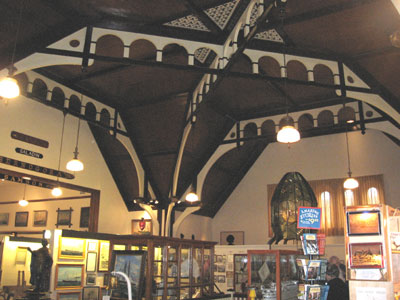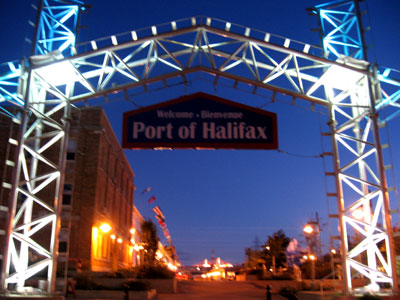I had really enjoyed my breakfast at the Garrison House B&B in Annapolis Royal, but my second day of explorations had begun and no time was to be wasted. I had a big drive ahead of me and my first quick stop was at Fort Anne where I met Alan Melanson, the Parks Canada Ranger and expert historian who had guided the entertaining and informative Candlelight Graveyard Tour last night.
He had promised me yesterday that he would show me the Fort Anne Heritage Tapestry, a collective effort of more than 100 volunteers who brought 4 centuries of history to life. 95 different colours of Persian wool were interwoven and stitched to form a historic tableau that is unique in Canada. It is about 18 feet long and 8 feet high and even Queen Elizabeth herself, on one of her travels to Canada, made a few official stitches in this tapestry. Alan himself, as a 9th generation Acadian, added to the artwork by stitching a few drops of red blood in the section on the Acadian deportation.

Alan points out the Queen’s stitches
Pressed for time I thanked Alan and made my way to another unique facility in Annapolis Royal: the Tidal Power Generation Station. Les West who works in the tourism office located on the main floor of the power plant, gave me a quick half hour introduction to the only tidal power generating plant in Canada, one of only two in the world. Les explained that Nova Scotia uses a variety of electricity generating methods, including oil, gas, hydro, wind and tidal power. Its topography with its low-lying hills is not perfectly suited for hydro generation, so during the 1970s, when oil prices were really high, the government devised plans to take advantage of tidal energy.
The Annapolis Royal site was chosen due to its high tides and a permanent causeway was built across the Annapolis River. A stainless steel straight-flow turbine was installed by a Swiss engineering firm and from 1980 onward tidal energy was taken advantage of. Today the Annapolis Royal Tidal Generating Plant produces enough energy for about 4500 homes in the area. More power is brought in as back-up when the tidal power plant does not produce enough energy.

The Annapolis Royal Tidal Generating Plant
Les also explained that the construction of the power plant and the permanent barrier in the river has had significant effects on the eco-system in the Annapolis River: the river has silted up considerably and sediment builds up at a rate of about 6 inches a month. Because of the significant ecological consequences of this construction it is unlikely that a similar project will be built in the future. However, electricity-generating projects that do not create permanent barriers may still be considered in areas of strong tidal current flows. Lessons have been learnt from the realization that even though tidal power in theory is a renewable, green source of energy, the design of the power plant can still have a major effect on the local environment.

Scallop boats in the Annapolis River
It was time to say goodbye to Annapolis Royal after an interesting 20 hours or so in this historic region and make my way westwards towards the Bear River Heritage and Cultural Center where I would receive an interesting introduction to Nova Scotia’s Mi’kmaq culture (written up in a separate article). I set off on my coastal drive through rolling green hills whose colours were just changing. Tidy little villages such as Upper Clements and Clementsport were flying by until I turned northwards into the Bear River reserve for my visit at Bear River Cultural and Heritage Centre.

The beautiful Bear River
After my two hour introduction to native culture in Nova Scotia I set off again on my westward drive and enjoyed the beautiful views along the meandering Bear River. I linked up with the coastal road again and slowly made my way into Digby, a local fishing town and a major settlement in the area. I parked my car and decided to take a quick stroll through Digby on a beautiful sunny and warm afternoon.
Digby was settled in 1783 by the United Empire Loyalists under the leadership of Sir Robert Digby. The town’s economy is based on two major industries: fishing (Digby is famous for its scallop fishing fleet) and tourism. As early as the late 1920, a big resort called The Pines was built on the outskirts of town, and to this day Digby is a popular tourist destination. One of the major attractions in the area are the world’s biggest tides in the Bay of Fundy. Digby also hosts an annual Scallop Days Festival which introduces tourists to the history and heritage of the town.

Waterfront view in Digby
I strolled along the waterfront and noticed the many waterfront restaurants that specialize in so many of Nova Scotia’s marine delights including lobster, crabs, shrimps, scallops and various types of fish. I had a quick soup and salad at the Shoreline Restaurant and enjoyed my lunch with a nice view of the waterfront. Less than an hour later I hopped back into my car to continue my journey to Yarmouth.

The granite church of St. Bernard




